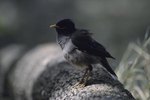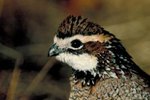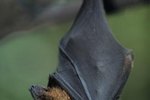
On a given summer, humans, cattle and horses are tormented by horseflies. They are large insects that feed on blood and can be found in your yard. They bite with their sharp mouth parts, inflicting a painful sting sensation, creating a pool of blood from which they feed from, unlike most insects that suck blood directly from their host. Horseflies require only a few seconds contact with your skin to bite and their presence in your yard attracts birds that feed on them. These birds help in reducing the population of horseflies.
Black-Headed Grosbeak
Black-headed grosbeaks are songbirds with large, conical, thick bills. Their colors are dependent on the sex of the bird; the breeding male has an orange cinnamon body with a black head and black and white wings, while immature males and females are brown in color with an orange patch on the breast. The black-headed grosbeaks can be found mostly in western United States in thickets and forest edges as well as backyards and gardens. The male and female black-headed grosbeaks share domestic tasks, such as feeding the young ones, as well as defending their nesting territories. They prey on a variety of insects, among them horseflies and caterpillars.
Sparrows
Sparrows are among the most abundant birds in North America and can mostly be seen traveling in flocks. Known to eat grains in the garden as well as a wide range of insects, horseflies included, sparrows can become a nuisance to your home if left to overpopulate. They build their nests in the walls of your house, ruining the wood. Their feces too can be of danger to human health. In spite of this, they can be of great importance in reducing the horsefly population around homes.
Swallows
Swallows eat mostly insects as well as grain, seeds and fruits, and live near fields and areas with abundance of flying space and natural water supply. They are fast flying songbirds that have colors ranging from a dull brown to blue and white bellies and inhabit most of North America. Flying insects such as horseflies are the major source of food for swallows, which can be interesting to watch as they fly by feeding while in midair.
Warblers
Warblers are insectivorous birds that eat spruce budworms and horseflies. Their population often fluctuates in proportion to the population of insects they eat. There are about 50 different species of warblers. They are small songbirds with white underparts, green backs, and sport a white line over their eyes. The juvenile warblers are darker green with a distinctive pale eye line and pale yellow underparts.
References
Photo Credits
-
Jupiterimages/Photos.com/Getty Images
Writer Bio
Carl Maresh is a writer and editor specializing in pet care, animals, careers and emergency management. He previously ran an animal shelter, where he also served as a kennel attendant and dog trainer.Maresh holds a Ph.D and Master of Science in physiology and a Bachelor's degree in physical education.



